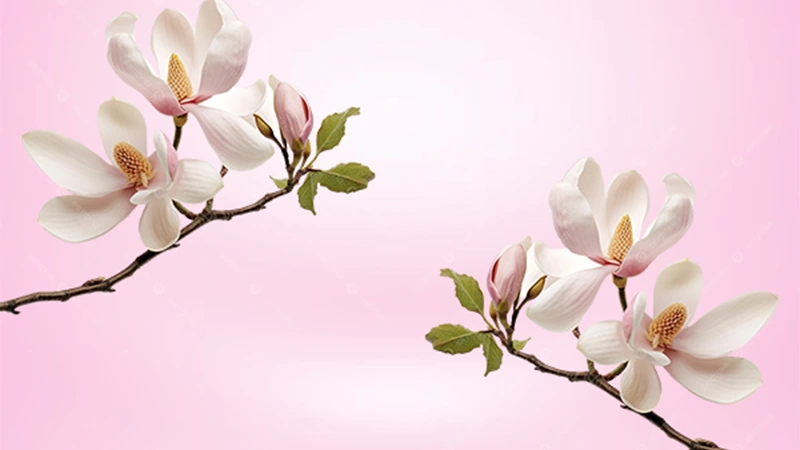
Native to North-South America and Asia, Magnolia Flowers are bowl-shaped, generally white-petaled fragrant flowers with lush green leafy foliage. Typically located at the branch tips, these blooms can attain a height up to 12 inches (ca. 30.48 centimeters) across. Rewarded with its beauty and elegance, Magnolia has captivated the affection of gardens and Anthophiles for centuries.
Whether you are considering growing Magnolia flowers in your garden or simply want to know more about this beauty, this article is intended to enlighten you about its significance and plantation. Let’s delve into the guide and learn more about the care this flower needs.
Magnolia Flowers Overview and Significance
Magnolias are one of the oldest tree species, evolving during the Cretaceous period 95 million years ago. Check the table featured below to extend your knowledge about this tree. Apart from this, give a good read to the meaning and symbolism it carries in different cultures.
Botanical Overview of Magnolia Flower
| Scientific Name | Magnolia Grandiflora |
| Popular Name | Southern Magnolia, Chinese Magnolia, Bull Bay |
| Plant Family and Type | Magnoliaceae family and Genus Magnolia |
| Native Area | Asia, Central and South America, and the West Indies |
| Size | 30 cm (12 in) in diameter |
| Flower Season | February and June (Depending upon the variety of flower) |
| Flower Color | Pink, Purple, White, and even Yellow |
| Maintenance | Low Maintenance |
| Exposure | Full Sun |
| Soil Type | Moist, slightly acidic and alkaline soils, |
| Soil pH | 5.5 and 6 |
| Lifespan | 80–120 years |
Here’s a quick sneak peek into the significance of the Magnolia tree in different cultures!
- Joy and purity: The gentle petals symbolize purity and joy. The flower is often associated with a new beginning, making it popular for weddings and celebrations.
- Beauty and elegance: This flower symbolized beauty and gentleness in ancient China because of its ivory-white color and shape. People also used this flower to portray a woman’s natural beauty and celebrate femininity.
- Determination and Patience: Magnolia trees are known to have long lifespans and a strong foundation, which is why they are usually linked with strong willpower and stability.
- Love and connection: In Victorian times, lovers exchanged the Magnolia flower as a symbol of their affection for each other. The strength and endurance of this flower represented an everlasting connection.
- Each color of the Magnolia flower holds a different meaning:
- White: Purity, nobility, and perfection.
- Pink: Youth, innocence, love, and joy.
- Purple: Good luck and health.
- Green: Joy, health, luck, and well-being.
Types of Magnolia Flowers
There are more than 130 Magnolia flower species worldwide. From the Southern to the Sweetbay Magnolia, every anthophile will likely find a suitable flower for their indoor space. We have listed some cherished trees that are mostly loved by flower enthusiasts.
1. The Southern Magnolia

The Southern Magnolia, also known by its botanical name “Magnolia grandiflora,” is an evergreen tree typically found in the southeastern United States. It produces large, white, glossy, approximately 12 inches (ca. 30 cm) in diameter fragrant flowers that bloom throughout the summer from May to June.
This tree will best thrive in USDA plant hardiness zones 6–10 when fertilized in early spring and mid-summer and watered around 2–3 times per week.
2. Magnolia Acuminata
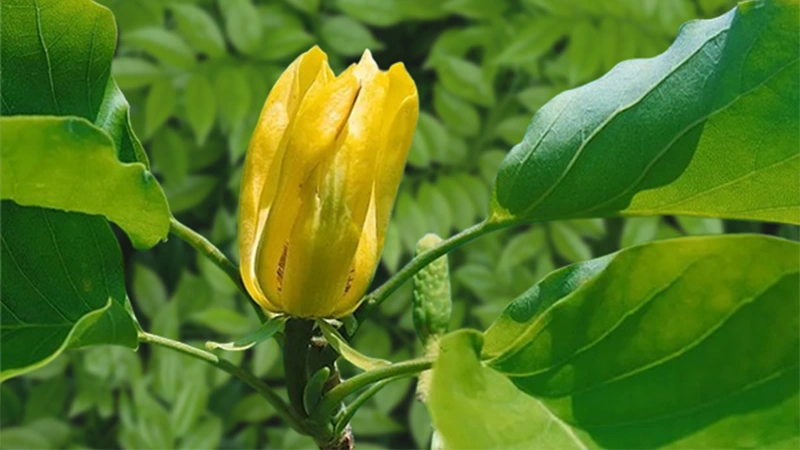
Magnolia acuminata, also known as the Cucumber tree, botanical name “Bauhinia acuminata L,” is native to Canada and southeastern Asia. The tree grows about 60–80 feet tall in the USDA hardiness zones of 3B–8 B. To spread a tree with an average life span of 100–150 years, two to three gallons of water per week for three to six months is required.
Also for best results, fertilize the plant in early spring when the tree is actively growing and again in mid-summer. In late spring, it will produce a tulip-shaped, fragrant greenish/yellow flower. Because of its symmetrical shape, this tree is suitable for parks, gardens, golf courses, and residential societies.
3. Saucer Magnolia
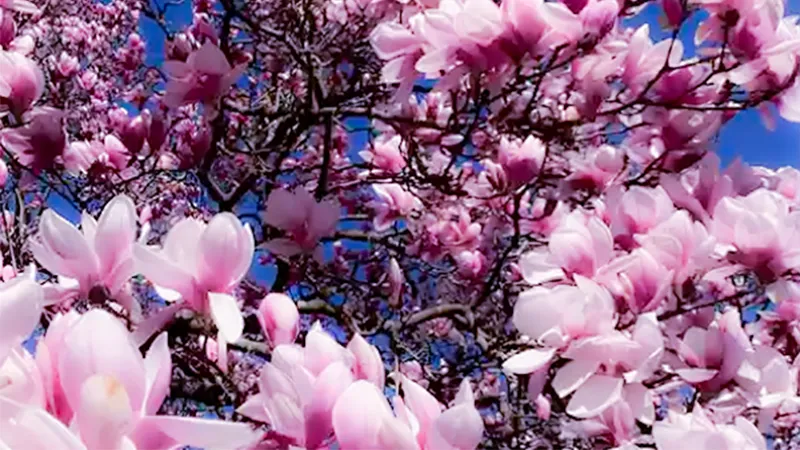
Native to Asia, the botanical name “Magnolia x soulangiana” can grow in USDA hardiness zones 4–9a. Since the petals of the flower are arranged in a goblet or saucer shape, this blossom is called Saucer Magnolia.
To enjoy the beautiful bloom, do not forget to fertilize it in spring and water the plant at least 1–2 times a week. This tree produces pink cup-like flowers in spring (March-April) that please every individual eye with their beautiful color and pleasant aroma.
4. The Sweetbay Magnolia

The Sweetbay bloom, botanical name “Magnolia virginiana,” is native to North and South America and can grow in north USDA hardiness zones of 5–10. These blooms are one of the most suitable plants for home gardens. To grow this plant, you have to deeply water them 2–3 times a week for the first 3–6 months.
The tree only reaches about 40 feet (ca. 12 m) tall and blooms in summer and spring. With its white petals and dark green leaves, this flower will delight the hearts of all florists.
5. Star Magnolia
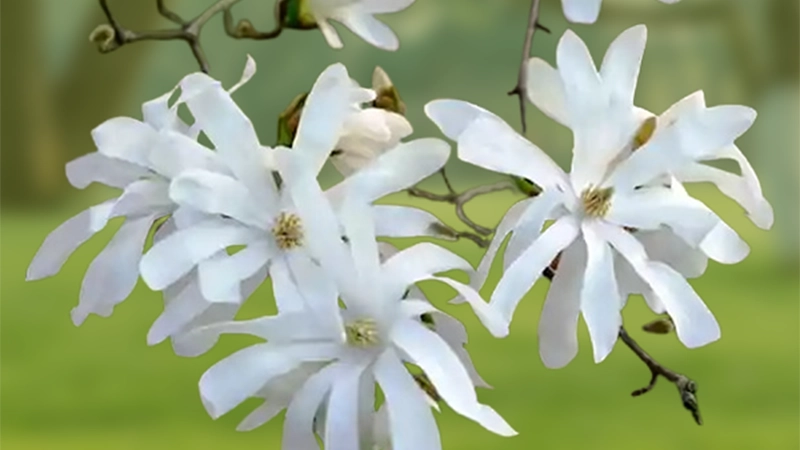
Star Magnolia, known by the botanical name “Magnolia stellata,” is Native to Japan. It is one of the smallest Magnolia species, which is tolerant to hot and cold weather, making them perfect for USDA hardiness zones 4-9.
The plant can grow up to 20 feet (ca. 6 m) tall and produces magnificent blooms during the late winter to early spring. To enjoy its petals, make sure to water thoroughly once a week and provide it with full sun.
6. Bigleaf Magnolia
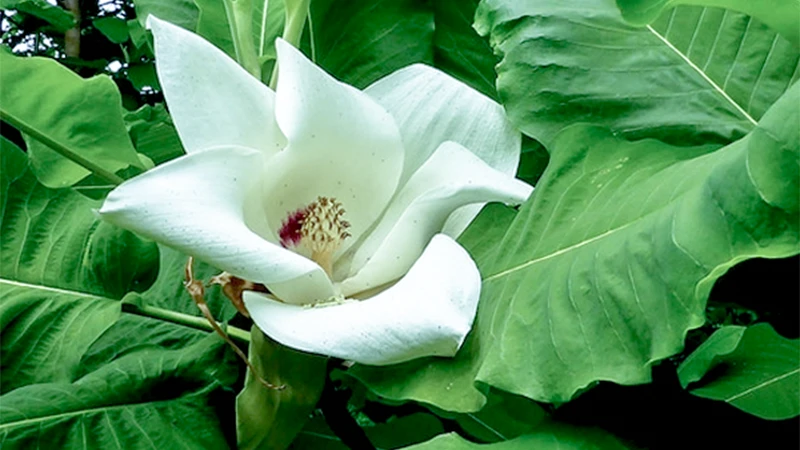
Justifying its name, Bigleaf Magnolia, botanical name “Magnolia macrophylla,” grows about 12-36 inch-long leaves. The tree is mainly found in the southeastern United States and eastern Mexico and grows well in the USDA hardiness zones of 5 to 9.
Water the plant about 2–3 times a week during the initial years of its growth, and provide fertilizer in early spring and late summer to early fall. Maintain the needs of this tree and enjoy its fragrant white blooms during the hottest days of May to July.
7. Lily Magnolia
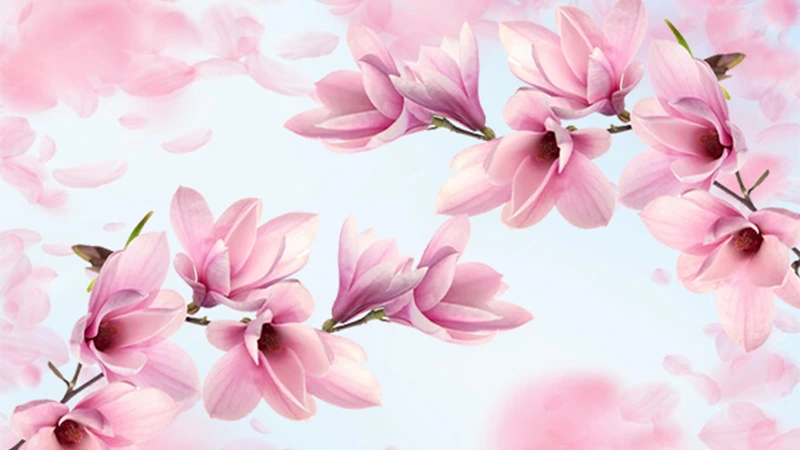
The botanical name “Magnolia liliiflora” is a cup-shaped petaled bloom that grows pointed upward. The tree is native to south-central and southeastern China and grows in the USDA hardiness zones 7-10. Since it accumulates about 8–10 feet in height, it is a perfect choice for small yards or gardens.
The flowers look like lilies, which grow in trees, hence the common name. Additionally, to enjoy the stunning bright pink-purplish bloom, make sure to provide it with a balanced fertilizer every month and water the plant once every 1–2 weeks.
Did you know?
Before bees existed, Magnolias evolved to be pollinated by beetles. The flowers produce large amounts of pollen instead of nectar to attract beetles.
How to Plant and Grow Magnolia From Seeds?
To successfully grow a Magnolia tree that will continue to grow for over a century, it is essential to carefully plan and put in the effort. The following are the fundamental steps that you should consider for farming a healthy plant.
1. Temperature and humidity
In general, Magnolia trees prefer full to partial sunlight and humid climates. Picking the location is key for healthy plant growth because it is sensitive to shady and cold areas.
Temperature and humidity for this tree vary, but always make sure to protect it from strong wind. Cultivate the plant within the USDA hardiness zones 4–10; it will do well on its own.
2. Prepare Seeds
For those who wish to grow Magnolia from scratch, it is going to be a long process. This bloom can be planted from fresh or moist berry seeds only.
Make sure to wash your seeds with detergent to remove the berry oil.
Place the seed into a well-moist compost or soil, and now carefully move it to an airtight bag or container. The next step is to store it in the refrigerator for the winter; the temperature should not be more than 4-5 degrees Celsius.
By mid-January, the seed will be ready to get planted, so transfer it to a pot. Water the pot properly and keep it in a warm area. If the process is done accordingly, then it will sprout within 4–6 weeks. The best way is to plant Magnolia the following year during the spring.
3. Prepare Soil
These trees thrive in moist and well-drained soil that is slightly acidic or alkaline. The plant can do well in sandy, loamy, and clay soil but can not cope with soggy soil. Make sure to use organic compost for your plants when they are young.
4. Dig a Hole
Once the Magnolia is ready to be planted at the final site, follow the instructions to grow a healthy tree. Firstly, dig a hole that is twice as wide as the tree’s root ball. Additionally, make sure to maintain a distance of about 5-8 square meters between trees to let them have plenty of space to grow.
5. Water
It’s essential to provide young Magnolia plants with plenty of water, especially during dry periods. Water the tree 3–4 times a week until it establishes itself, which typically takes around 2–3 years. Feel free to adjust the tree’s water needs according to the temperature and rainfall in your area.
Propagating Magnolia Trees
There are several ways to propagate Magnolia trees such as seeds, cutting air layering. The following will provide a brief about it.
1. Propagating from Seeds:
- Collect Seeds: Gather ripe seeds from your Magnolia tree or buy them from the store. Do not buy dried seeds because they are never likely to grow.
- Stratify Seeds: Place the seed into an air-tightened bag or container and refrigerate it for at least 60–90 days. This part is unskippable to make the seed familiar with winter conditions.
- Plant Seeds: After stratification, plant the seed into a pot filled with well-drained moist soil and compost mix.
- Care for the Seedling: Keep the potting soil well moist, and protect the seedling from direct sunlight during the initial days.
2. Propagation from Cuttings:
- Take cutting: Use a sharp and clean blade and cut about 6 to 8-inch long growing tips of branches that are healthy.
- Prepare the cutting: After cutting, remove the lower leaves and dip the cut end in the rooting hormone.
- Plant cutting: Prepare a vase filled with moisture-rich soil and then plant the cutting.
- Care for cutting: Keep the soil moist and the vase in a humid environment. Also, check the cutting because after 4 to 6 weeks it should start developing roots.
3. Air Layering:
- Select a branch: Choose a healthy and mature branch with a diameter of about 1 or 2 inches (5.08 cm).
- Cut: Make a small cut around the branch and remove plant bark.
- Wrap with moss: Cover the cut area with nice and firm sphagnum moss and wrap the moss with plastic wrap.
- Wait for growth: After 2 to 3 months, the plant should develop roots.
- Cut and pot: Once the roots are developed, cut the branch just below the root and transfer the cutting into a pot.
Additional Tips to Consider:
- Choose the right propagating method because it varies on the tree species and your personal preference.
- Another important factor in tree growth is being patient because the development process can take time.
- Once this tree is planted, it requires proper care and love. Make sure to provide the tree with water, and fertilizer along with this keep an eye out for pests and diseases.
Care Tips for Magnolia
Magnolias are generally low-maintenance trees once they are established. To grow a tree that will produce vibrant and healthy flowers, make sure to consider the following tips:
- During the initial years of plant growth, it is essential to provide fertilizers to nourish the tree. However, once the tree is healthy and stable, you can skip this part.
- Shaping and removing dead leaves is crucial for encouraging new blooms and promoting healthy growth. The plant requires morning and evening sunlight, so provide it some shade during the hottest part of the day.
- Keep an eye out for insects like mealybugs and scales. If the tree branches are dying out suddenly, then there is a chance that the tree is affected by fungal disease. To prevent it, cut down the dead parts and use pesticides to preserve the tree.
- Magnolia is a delicate bloom, so to grow them properly, make sure to water the plant according to its needs. The soil should be well hydrated but not soaking wet because that can damage the tree routes.
When and How to Prune Magnolia Tree
Magnolias can add beauty to various landscapes, but they also require maintenance to keep them healthy and growing. And here comes pruning, an important task to ensure the longevity of this tree.
1. When to Prune:
- After flowering: The best time to prune magnolia is after the flowering season because the tree does not bleed too much and recovers the damage quickly.
- Dormant season: For some species such as Southern magnolia, the best timing for pruning will be during winter.
2. How to Prune:
- Remove damaged parts: Removing dead and damaged wood or branches is the first reason for pruning. To promote a healthy tree life, remove any branches that are dying, infected, or crossing against each other.
- Shape the tree: If you have a specific preference for tree shape, start shaping from an early age. However, It is important to note that the tree is not tolerant of heavy pruning.
- Thin-out dense growth: If the tree growth is too thick, it is best to thin out some branches for air circulation and sunlight penetration.
3. Important Consideration:
- Using clean and sharp tools is recommended to prevent the spread of diseases within the tree.
- Not to mention, make clean cuts and avoid leaving stubs, as they can cause infections.
- Magnolias are slow-growing trees, and they might not recover from heavy pruning and start dying out of a sudden.
Common pests and problems in Magnolia flower
Magnolia trees are naturally strong and resistant to pests and diseases, but it is crucial to keep an eye out. Do not overlook the following issues to encourage a healthy tree life.
Pests
- Scale insects: to survive, these insects suck sap from leaves that cause yellowing and stunting. To control these scale insects, apply dormant oil or horticultural oil.
- Aphids: These insects can be observed under the tree, they also suck out tree sap and leave honeydew. To control aphids, start using need oil or insecticidal soap.
- Spider mites: These insects look like smaller-sized spiders and can cause yellowing and webbing on the leaves. Combat these insects with specialized mite control products or neem oil.
- Borers: These insects can infect newly planted trees or those with poor health, but they can also feed on healthy trees. Borers can damage the tree’s trunk and branches. Prevent the plant from borers by using basal bark spray or soil drench.
Diseases
- Powdery mildew: This is a fungal disease that causes white powdery patches on branches or leaves. It can be controlled by pruning and by improving air circulation around the tree.
- Leafy spot: It can be identified by the spots on leaves that can vary in size, color, and shape depending on the plant. Combat this disease with fungicides or by removing dead leaves.
- Root rot: The first sign of this disease is that it will cause the roots to rot. Additionally, leading the leaves to turn yellow or brown. To treat root rot, gently snip off the brown roots and avoid over-watering the tree.
- Canker diseases: The typical sign of this disease is that it will cause crackers on the branches, leading to dieback. Make sure to prune the infected branches, but be cautious about injuring the bark.
By combatting this common problem in the plant, you can maintain a healthy and beautiful magnolia tree.
Incorporating Magnolia into Your Life
Magnolia can enhance any space, whether it’s an indoor garden or simply for decoration. Incorporating Magnolia into your daily life can add beauty and a sense of stability. Here are some ideas:
- Plant in the garden: Plant a Magnolia tree in your garden for seasonal blooms; not only will this flower enhance the beauty of your space but also will become the centerpiece of attraction.
- Floral arrangements: The beautiful flowers can be used as a focal point in floral arrangements, making them a perfect choice for childbirth, engagements, and other celebrations. Also, white Magnolia flowers are used in the wedding ceremony to show the purity and innocence of a new relationship.
- Gifts: The Magnolia flower has an aromatic essence that can be preserved by creating scented candles. It’s a thoughtful and creative way to incorporate the nature of these plants into everyday life, allowing more people to experience their unique scent.
- Celebrating achievements: Because of the unusual size of the Magnolia flowers, they can be a good choice for congratulating someone’s achievement. Choose these flowers to gift someone on their college enrollment, a new job, or a promotion.
- Medical use: Magnolia was used to treat anxiety, insomnia, asthma, and digestive issues in traditional Chinese herbal remedies. When taken in a safe amount, this flower can treat various health issues.
Final Words
The Magnolia flower is much more than just a usual plant; it holds deep cultural meaning with it. These orchids are timeless symbols of love, purity, and celebration. Incorporating these flowers into your garden and home will not only elevate your space but also provide a sense of elegance and joy.
What makes the Magnolia tree special?
Magnolia is known for its large, vibrant flowers that have an enchanting aroma.
Can I plant a Magnolia in my garden?
Yes, you can plant this tree in your backyard with care.
Does Magnolia flower need a lot of care?
When planted, this flower does require a lot of care, but once established, it will do well on its own.
What is the oldest Magnolia tree in records?
The oldest tree on record is 320 years old in Italy.
Can I gift a white Magnolia in a religious ceremony?
Yes, Magnolia flowers can be offered in religious ceremonies.






